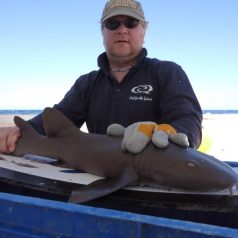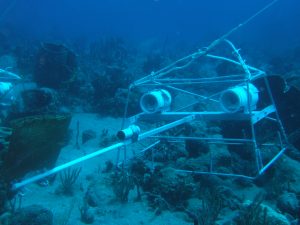
One of the research objectives around the Dutch Caribbean islands is to figure out how sharks move around, and for what purposes they use the area. And equally urgent is to officially determine what species actually occur around the islands. Because of the lacking historical data on the diversity, and relative abundance of species, there is still no reference against which to measure the effect of protection measures in the future. Therefore, in addition to their acoustic telemetry study, researchers from Imares Wageningen UR are engaged in monitoring shark communities around the Dutch Caribbean. Which they do by using so-called BRUVs: baited remote underwater videos.

These stereo video cameras are dropped to the bottom of the sea for one hour and record on film the animals that are attracted by the bait, which hangs in a metal case in front of the camera. Initially, BRUVs in the Dutch Caribbean were primarily used to monitor fish communities on coral reefs, but the focus has now shifted to watching sharks. The first recordings on the seabed of Saba (Saba Bank), St. Eustatius and St. Maarten were completed last year. Next up, Curacao is on the agenda for coming fall, and finally, Bonaire will be analyzed in 2017.
The use of underwater cameras is a research method with various advantages and disadvantages. Because the sharks do not have to be caught, the method is very non-invasive and causes no unnecessary stress to the sharks. And the length of fish can be determined because of the use of stereo cameras. However, recognizing the exact species and its sex is not always possible, because the sharks do not always swim parallel past the camera.
The data that are now collected will constitute a so-called baseline study and will especially be useful after comparing them with data from a repeat in a few years. But in the short term, the data could be compared to data from BRUV research collected in other locations around the world. If particular patterns are observed, for instance between shark communities in areas with different levels of protection, inferences can potentially be made about their successfulness. The first impression of head researcher De Graaf is that at certain spots around the islands, such as on the Saba Bank, there is still a considerable amount of sharks that pop up in the video. About a third of the films show sharks and about half of them show either sharks or rays. And even though you can derive no absolute numbers or inferences from this, it does suggest that the island still provides ample suitable habitat for particular species.
The underwater monitoring program is led by IMARES researcher Martin de Graaf. Martin has been closely connected to the Dutch Caribbean throughout his career, ever since he first started doing research on Bonaire in the ‘90s, studying parrotfish and coral reefs. After several years working in Ethiopia and Australia as a freshwater biologist, he got a chance at Imares in 2010, to return to marine biology and the colored reefs of the Caribbean. The first time an actual tiger shark appeared on the footage was an unforgettable moment for Martin de Graaf: “I often got called in by the students as soon as something large swam by on the video, but the first time we saw an actual tiger shark was pretty impressive, for us all”. Other species that already appeared on the footage are nurse sharks, Caribbean reef sharks, blacktip sharks and a single silky shark.





